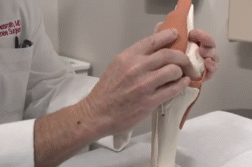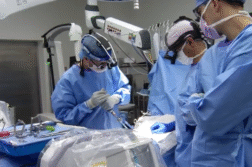CHICAGO, Ill. (Ivanhoe Newswire)— At its peak, 62 percent of Americans were working from home during COVID, creating a shift in the modern workplace. Kitchen tables have turned into work desks and couches and recliners are now our office chairs. While we may feel cozy, experts say our new home workspace could be creating chronic back problems in the months and years to come.
You may think working from home has taken the weight off your shoulders, but think again, especially if you’ve been feeling shoulder, neck and back pain.
“If you’re just sitting on a couch, with the laptop sitting on your thighs, your arms may be comfortable, but your head, neck, shoulders are all going to have this downwardly rotated posture; that’s absolutely the worst thing you can do,” explained Grant Garrigues, MD, a shoulder surgeon at Midwest Orthopaedics at Rush.
Doctors say in that position, the rotator cuff is being pinched. Over time, it can result in serious injuries.
“Suddenly doing overhead activity where the shoulder blade needs to roll back fully, but it can’t anymore because it’s lost that flexibility in the front and the strength in the back, leads to big problems,” elaborated Dr. Garrigues.
Doctors say if you find yourself working from home for a period of time, proper positioning of your laptop is key.
“By definition your hands are down low on the keyboard, then the screen is going to be down low too, that’s going to lead to neck flexion,” illustrated Dr. Garrigues.
Place your monitor at arm’s length, so the top of your screen is at or slightly below eye level. And if it can’t adjust, prop it up on a riser or books. Keep your desk at a height where your elbows and wrists are level with the tabletop. And use a firm, upright chair that provides support. If needed, rest your feet on a stool that allows a 90-degree angle for your knees and hips. With steps to prevent shoulder, neck, and back problems.
If it works in your work from home budget, doctors say a standing desk is a great option. But don’t start with eight hours on the first day. Just keep it 30 minutes, and then gradually increase your standing over time. Also, be sure to take short breaks. One routine is called the 20/20/20 rule. For every 20 minutes spent looking at a computer screen, you should spend 20 seconds looking at something else 20 feet away. This gives your eyes a break and helps reduce neck strain.
Contributors to this news report include: Cyndy McGrath, Executive Producer; Addlyn Teague, Field Producer; Roque Correa, Editor.
To receive a free weekly e-mail on Medical Breakthroughs from Ivanhoe, sign up at: http://www.ivanhoe.com/ftk
Sources:
https://www.mayoclinic.org/diseases-conditions/rotator-cuff-injury/symptoms-causes/syc-20350225
https://www.cedars-sinai.org/blog/home-office-ergonomics.html
http://www.bu.edu/articles/2020/10-ergonomics-dos-and-donts-for-those-now-working-from-home/
https://www.ehstoday.com/health/article/21127667/ergonomics-recommendations-for-remote-work
MEDICAL BREAKTHROUGHS
RESEARCH SUMMARY
TOPIC: WORKING FROM HOME … BAD BACK EPIDEMIC?
REPORT: MB #4834
BACKGROUND: In March when the Centers for Disease Control declared COVID-19 a pandemic, many Americans began to shelter in place and work from home. Work from home is an efficient way to keep businesses running while staying socially distant. At its peak, 62 percent of Americans were working from home and many say they will not return to the office even when it becomes safe to do so. Gallup Panel data showed that, “Three in five U.S. workers who have been doing their jobs from home during the coronavirus pandemic would prefer to continue to work remotely as much as possible, once public health restrictions are lifted. In contrast, 41% would prefer to return to their workplace or office to work, as they did before the crisis.”
(Source: https://news.gallup.com/poll/306695/workers-discovering-affinity-remote-work.aspx)
EFFECTS: Work from home helps containing the spread of the COVID-19 virus, but it has other health risks that come with it. Ergonomics refers to the study of people’s efficiency in the workplace and how work can be tailored to limit risk of injury or discomfort to the worker. Doctors saw an increase in patients coming to see them for shoulder, back and neck pain during the COVID rise. Patients would complain of pain in the anterior superior shoulder, express that it was worse with activity and reaching out. This could be directly correlated with working in non-office environments such as kitchen tables, couches, and beds. Use of laptops on a person’s actual lap is another major issue that involves hunching over and can pinch the rotator cuff over time.
(Source: Grant Garrigues, MD, shoulder surgeon, Midwest Orthopaedics at Rush)
REMEDIES: To prevent injuries to the shoulder, neck and back while working from home, don’t work on your bed or couch. You are more likely to slouch from your neck and shoulders in this position, flexing your entire spine. Work with your computer and chair at an appropriate height. You want your elbow to naturally meet the top of the table and permit neutral wrist flexion. Your computer should be at eye level to limit the strain on your neck from looking down. Have your feet flat on the floor to lessen the pressure on your joints. Additionally, a stool can be used to prop up your legs to a 90-degree angle. It’s also important to take frequent breaks about every 20 minutes to keep blood flowing and open up your neck and back muscles and reduce the strain from looking at your computer monitor.
(Source: https://rhfamilychiro.com/2020/05/16/work-from-home-ergonomics/)
FOR MORE INFORMATION ON THIS REPORT, PLEASE CONTACT:
ANN PITCHER
630.234.4150
If this story or any other Ivanhoe story has impacted your life or prompted you or someone you know to seek or change treatments, please let us know by contacting Marjorie Bekaert Thomas at mthomas@ivanhoe.com




